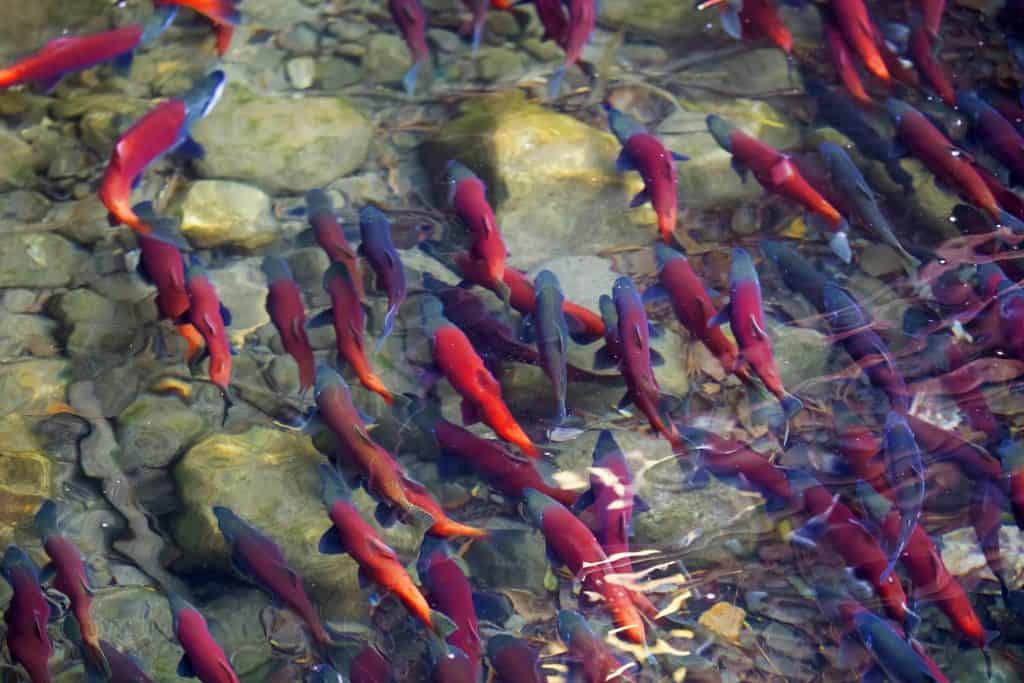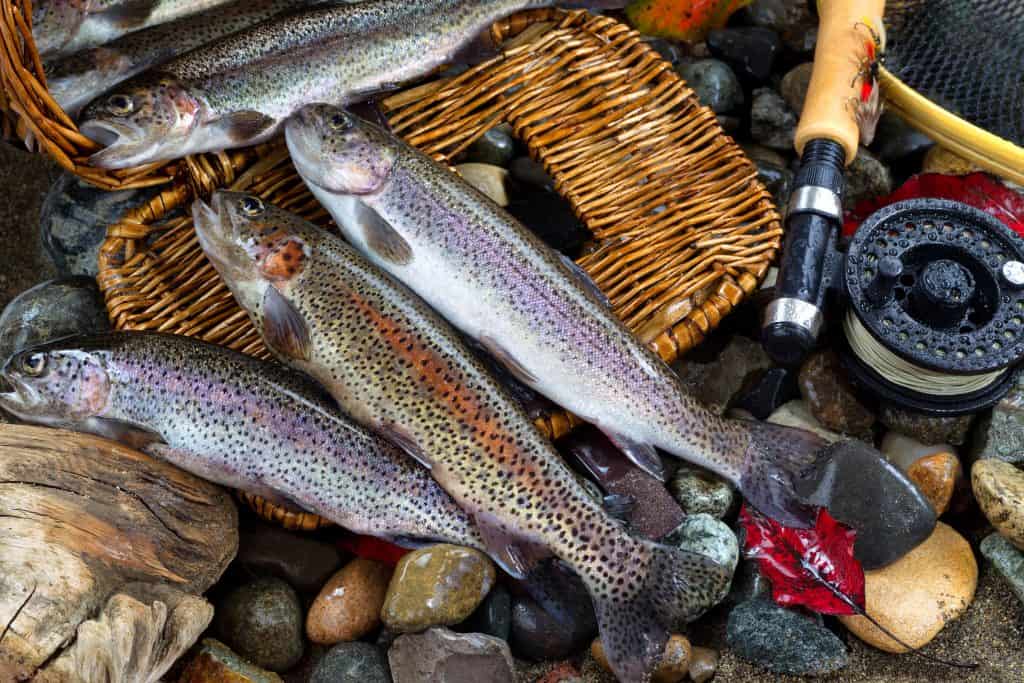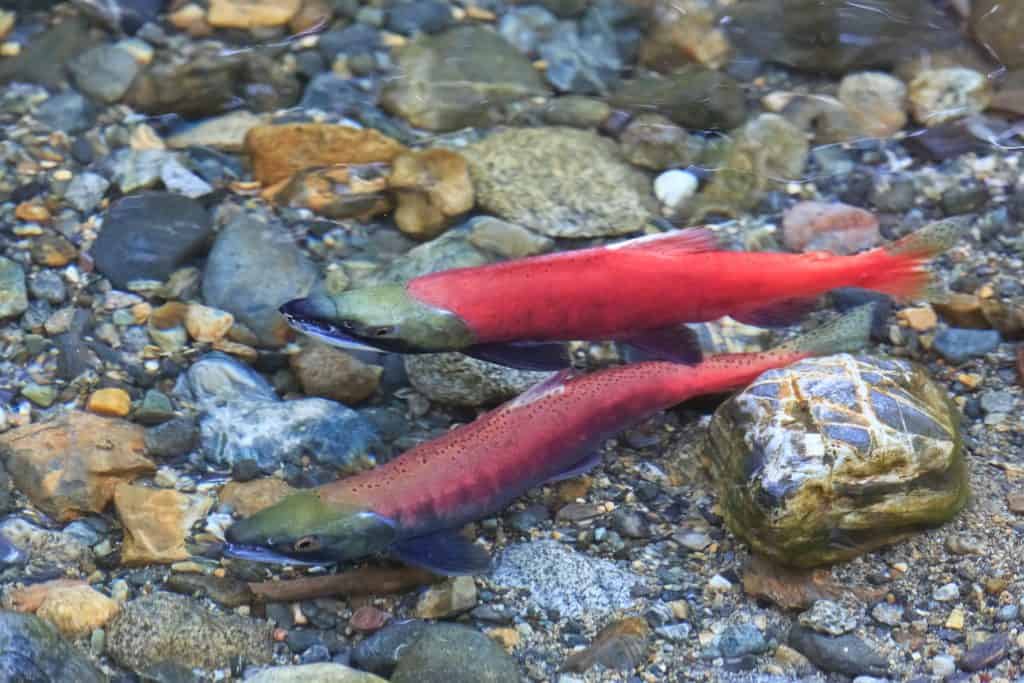
Rainbow Trout and Kokanee Salmon are the two most targeted fish on the west coast. They are both delicious fish and are both fun to catch, two of the main reasons they are so popular. There are many fisheries on the West Coast, from California to Canada and Alaska, that have made it their purpose to maintain a steady population of Rainbows and Kokes in the lakes and surrounding rivers.
But what is the difference between Rainbow Trout and Kokanee Salmon? Rainbow Trout are a type of ocean-going trout with two branches of species. The steelhead branch spends most of their time in the ocean, while the main branch spends all of its time in freshwater. Kokanee Salmon are landlocked in lakes and even those in rivers do not have the urge to seek the ocean.
Rainbow Trout

Rainbow Trout have two branches, or subspecies considered Rainbow Trout. The main branch, simply called Rainbow Trouts, are smaller than the other branch. These are usually the fish that are talked about when talking about Rainbow Trout. They taste amazing and give a good fight on the hook.
The second branch are called Steelhead Rainbow Trout. Steelheads are ocean-dwelling trout that are bigger and more aggressive than river Rainbows.
Biology
The average size of a rainbow trout, not a steelhead, is around 2 – 5 lbs. This is a good sized fish to eat, and one can feed one person easily. When I catch Rainbows, I usually catch three or four, depending on the bag limit, and feed my family a delicious dinner. The Rainbow Trouts have an average length of around 12 – 30 inches.
A steelhead’s average weight is 8 – 11 lbs. They are larger than ra
A freshwater rainbow trout can have all the colors of the rainbow of their back and sides, or they can be a dull olive-brown or dark blue. Their bellies are usually silver or pale, but are always a lighter color. The colors of their scales depends on their location, maturity, and sex.
The steelhead variation tends to be more silvery and narrower in proportion, while being longer and larger.
Lifecycle
Rainbows can spend their entire lives living in a river, returning to a specific point in the river to spawn. Unlike other types of fish, the trouts can spawn multiple years in a row without dying. Some trout spend part of their lives in the ocean, but they always return to the rivers and streams to
Steelhead trout spend the majority of their lives in the ocean, returning only to spawn. Steelheads are larger than rainbows and are so because of the rich nutrients found in the ocean. The rivers would not be able to support a trout that big, unless the population of fish was depleted to nearly zero.
When rainbow trout spawn, it doesn’t matter too much if the parent was a residential rainbow trout or a steelhead rainbow trout. The offspring could be either a steelhead or a smaller river rainbow trout.
Both the freshwater rainbows and the steelhead can live around 11 years, but not many make it to being alive that long. They tend to average around 4 – 6 years.
Kokanee Salmon

Kokanee Salmon are actually land-locked Sockeye salmon, a different ocean-dwelling fish. Kokanee salmon, or Kokes, spend their complete life in fresh waters. Some populations are completely stuck in the lakes they live in, while others have access to rivers and streams. Some even have a way to the
Biology
Kokanee salmon, although related to Sockeye salmon, are a lot smaller than their ancestral species. Because the lakes and rivers don’t have enough nutrients, or in their case plankton, the Kokes cannot get as large as the ocean-dwelling Sockeye salmon.
The average weight for a Kokanee salmon is only 1 lb. Some can get up to 3 – 5 lbs, but that is not very common. Most that get close are caught by humans or eaten by other fish, usually rainbow trout.
The average length of a Kokanee salmon is 9 – 12 inches.
Kokanee salmon are silver fish, but only until its time to spawn. When that time comes around, the males turn a deep red and start to develop a hump on their back. Their jaw becomes hooked and they get some wicked looking teeth.
When the males turn red, their meat begins to ripen. This is because as they start to get ready to spawn, their bodies begin to die. The red is the first indicator of a dying fish, so when it starts, their meat deteroriates.
Life Cycle
The life cycle of a Kokanee salmon is pretty standard. Starting at an egg placed in a stream, most Kokanee salmon start life off in a small stream. Once they get big enough, they travel to a lake or a river, if they aren’t already there.
Once they arrive there, they usually spend the rest of their lives in that one lake, occasionally getting hooked by a fisherman, or chased/ attacked by rainbow trout.
Kokanee salmon never enter a saltwater body of water in their lives. They spend 100% of their time in freshwater and most populations are completely stuck in a lake of some sort.
There are many fisheries that place fish into lakes to get a population going. These fish will face many hardships after being introduced to a new lake.
Sometimes the food sources aren’t enough to support a large number of them. There is also the fear of rainbow trout eating them.
Differences between Rainbows and Kokes
Trout and salmon are very similar, but they are different species of fish and thus have their significant differences
Diet – Rainbow trout are omnivores, meaning they eat plants and meat. Usually, rainbows eat insects that fell into the river, but they also eat mice and frogs, and are known to eat other fish. Rainbow trout, especially the steelheads, love to eat Kokanee salmon. They do not eat other rainbows, however.
Kokanee salmon
Caudal Fin (tail) – Rainbow trout’s tails are not notched very much. They are more square than they are forked. Kokanee salmon, on the other hand, has a very notched tail. The dorsal fin on the Kokanee is more of a right triangle, starting from the point of the fin. On a rainbow, the tip is created by an obtuse angle that gives it more of a sloping look compared to the Kokanee’s drop-down fin.
Location – Kokanee can only be found fresh water such as lakes and some rivers. Most Kokanee can only be found in the North Western parts of America, including the USA and Canada.
Rainbow trout have been introduced to every continent on the planet, with the exception of Antarctica, successfully. Rainbow trout can live in freshwater lakes and rivers, but can also thrive in the salt waters of oceans and seas. The freshwater branch are small enough to live in some streams as well.
Kokanee salmon and rainbow trout are very similar in some ways, but in others, they couldn’t be more different. They are both extremely tasty fish and are fun to catch. Try your luck with catching these and see just how fun they can be to catch and eat yourself!
Related Questions:
Are Trouts a type of Salmon? Salmons
Do Kokanee and Rainbow taste the same?
